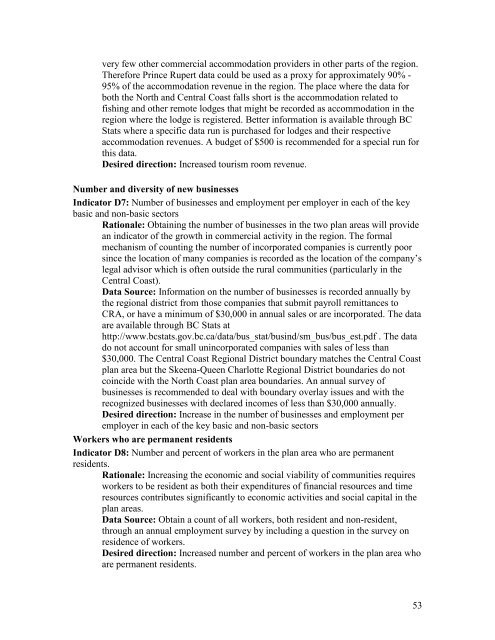Final report - Integrated Land Management Bureau
Final report - Integrated Land Management Bureau
Final report - Integrated Land Management Bureau
Create successful ePaper yourself
Turn your PDF publications into a flip-book with our unique Google optimized e-Paper software.
very few other commercial accommodation providers in other parts of the region.<br />
Therefore Prince Rupert data could be used as a proxy for approximately 90% -<br />
95% of the accommodation revenue in the region. The place where the data for<br />
both the North and Central Coast falls short is the accommodation related to<br />
fishing and other remote lodges that might be recorded as accommodation in the<br />
region where the lodge is registered. Better information is available through BC<br />
Stats where a specific data run is purchased for lodges and their respective<br />
accommodation revenues. A budget of $500 is recommended for a special run for<br />
this data.<br />
Desired direction: Increased tourism room revenue.<br />
Number and diversity of new businesses<br />
Indicator D7: Number of businesses and employment per employer in each of the key<br />
basic and non-basic sectors<br />
Rationale: Obtaining the number of businesses in the two plan areas will provide<br />
an indicator of the growth in commercial activity in the region. The formal<br />
mechanism of counting the number of incorporated companies is currently poor<br />
since the location of many companies is recorded as the location of the company’s<br />
legal advisor which is often outside the rural communities (particularly in the<br />
Central Coast).<br />
Data Source: Information on the number of businesses is recorded annually by<br />
the regional district from those companies that submit payroll remittances to<br />
CRA, or have a minimum of $30,000 in annual sales or are incorporated. The data<br />
are available through BC Stats at<br />
http://www.bcstats.gov.bc.ca/data/bus_stat/busind/sm_bus/bus_est.pdf . The data<br />
do not account for small unincorporated companies with sales of less than<br />
$30,000. The Central Coast Regional District boundary matches the Central Coast<br />
plan area but the Skeena-Queen Charlotte Regional District boundaries do not<br />
coincide with the North Coast plan area boundaries. An annual survey of<br />
businesses is recommended to deal with boundary overlay issues and with the<br />
recognized businesses with declared incomes of less than $30,000 annually.<br />
Desired direction: Increase in the number of businesses and employment per<br />
employer in each of the key basic and non-basic sectors<br />
Workers who are permanent residents<br />
Indicator D8: Number and percent of workers in the plan area who are permanent<br />
residents.<br />
Rationale: Increasing the economic and social viability of communities requires<br />
workers to be resident as both their expenditures of financial resources and time<br />
resources contributes significantly to economic activities and social capital in the<br />
plan areas.<br />
Data Source: Obtain a count of all workers, both resident and non-resident,<br />
through an annual employment survey by including a question in the survey on<br />
residence of workers.<br />
Desired direction: Increased number and percent of workers in the plan area who<br />
are permanent residents.<br />
53
















